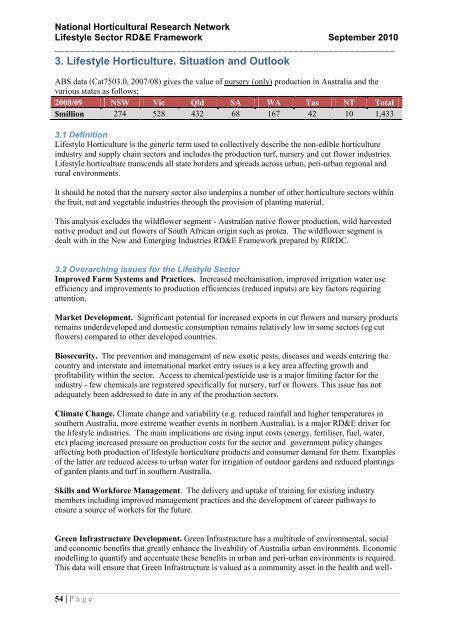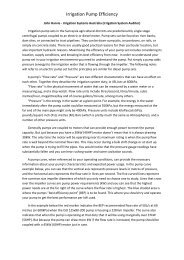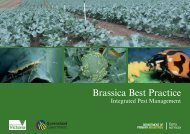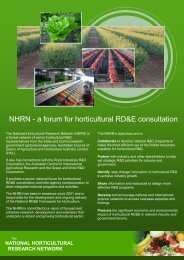National Horticultural Research Network - Horticulture Industry ...
National Horticultural Research Network - Horticulture Industry ...
National Horticultural Research Network - Horticulture Industry ...
You also want an ePaper? Increase the reach of your titles
YUMPU automatically turns print PDFs into web optimized ePapers that Google loves.
<strong>National</strong> <strong>Horticultural</strong> <strong>Research</strong> <strong>Network</strong><br />
Lifestyle Sector RD&E Framework September 2010<br />
___________________________________________________________________<br />
3. Lifestyle <strong>Horticulture</strong>. Situation and Outlook<br />
ABS data (Cat7503.0, 2007/08) gives the value of nursery (only) production in Australia and the<br />
various states as follows;<br />
2008/09 NSW Vic Qld SA WA Tas NT Total<br />
$million 274 528 432 68 167 42 10 1,433<br />
3.1 Definition<br />
Lifestyle <strong>Horticulture</strong> is the generic term used to collectively describe the non-edible horticulture<br />
industry and supply chain sectors and includes the production turf, nursery and cut flower industries.<br />
Lifestyle horticulture transcends all state borders and spreads across urban, peri-urban regional and<br />
rural environments.<br />
It should be noted that the nursery sector also underpins a number of other horticulture sectors within<br />
the fruit, nut and vegetable industries through the provision of planting material.<br />
This analysis excludes the wildflower segment - Australian native flower production, wild harvested<br />
native product and cut flowers of South African origin such as protea. The wildflower segment is<br />
dealt with in the New and Emerging Industries RD&E Framework prepared by RIRDC.<br />
3.2 Overarching issues for the Lifestyle Sector<br />
Improved Farm Systems and Practices. Increased mechanisation, improved irrigation water use<br />
efficiency and improvements to production efficiencies (reduced inputs) are key factors requiring<br />
attention.<br />
Market Development. Significant potential for increased exports in cut flowers and nursery products<br />
remains underdeveloped and domestic consumption remains relatively low in some sectors (eg cut<br />
flowers) compared to other developed countries.<br />
Biosecurity. The prevention and management of new exotic pests, diseases and weeds entering the<br />
country and interstate and international market entry issues is a key area affecting growth and<br />
profitability within the sector. Access to chemical/pesticide use is a major limiting factor for the<br />
industry - few chemicals are registered specifically for nursery, turf or flowers. This issue has not<br />
adequately been addressed to date in any of the production sectors.<br />
Climate Change. Climate change and variability (e.g. reduced rainfall and higher temperatures in<br />
southern Australia, more extreme weather events in northern Australia), is a major RD&E driver for<br />
the lifestyle industries. The main implications are rising input costs (energy, fertiliser, fuel, water,<br />
etc) placing increased pressure on production costs for the sector and government policy changes<br />
affecting both production of lifestyle horticulture products and consumer demand for them. Examples<br />
of the latter are reduced access to urban water for irrigation of outdoor gardens and reduced plantings<br />
of garden plants and turf in southern Australia.<br />
Skills and Workforce Management. The delivery and uptake of training for existing industry<br />
members including improved management practices and the development of career pathways to<br />
ensure a source of workers for the future.<br />
Green Infrastructure Development. Green Infrastructure has a multitude of environmental, social<br />
and economic benefits that greatly enhance the liveability of Australia urban environments. Economic<br />
modelling to quantify and accentuate these benefits in urban and peri-urban environments is required.<br />
This data will ensure that Green Infrastructure is valued as a community asset in the health and well-<br />
54 | P a g e






